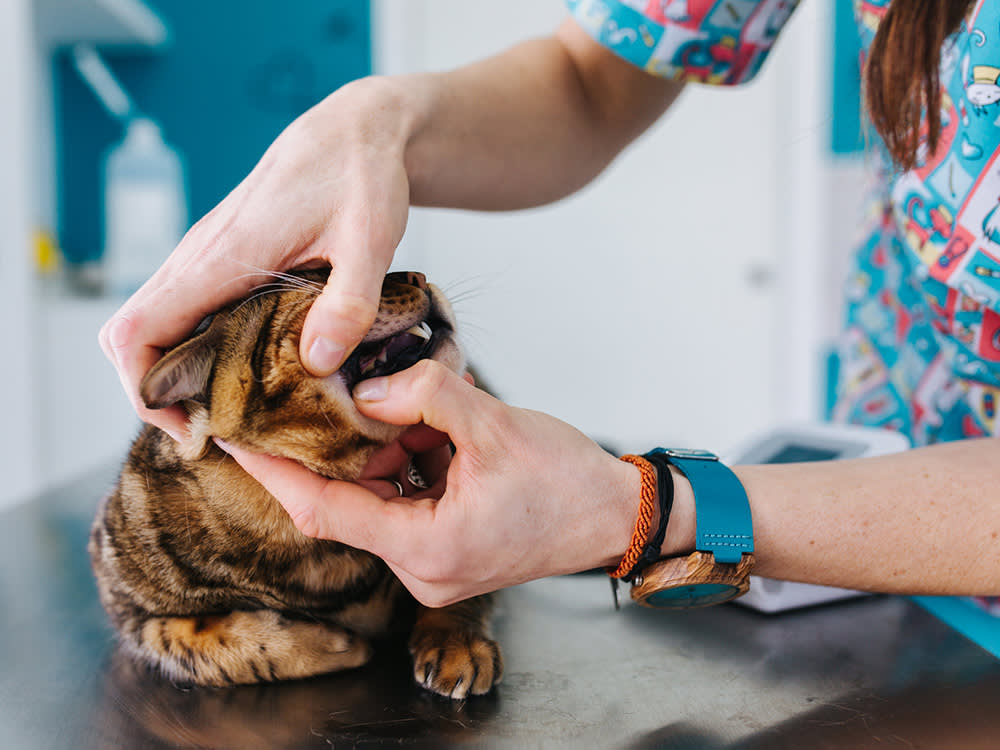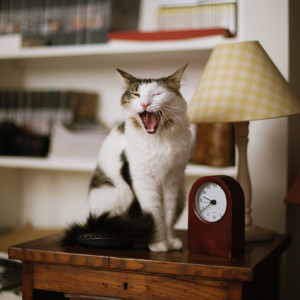What You Need to Know About Cat Mouth Ulcers
How to spot, diagnose and treat the painful lesions – whether cancerous or non-cancerous

share article
Most people don’t regularly poke around in their cat’s mouth, but sometimes you might think it’s necessary to take a peek to see what’s going on beyond their teeth. If there’s a sudden change in the smell of your cat’s breath or a weird spot you see when they yawn, it could indicate an underlying condition. Cats can develop ulcers in their mouths for several reasons, including certain diseases. Oral ulcers may indicate a local problem, or they could be a sign of a systemic disease.
What are mouth ulcers?
An ulcer is any break in the skin or mucous membranes (like the gums, tongue or cheeks) that results from the loss of normal tissue on the surface. This surface tissue can break down and develop a local area of necrosis (tissue death). The most common causes for ulcers in a cat’s mouth are dental disease, oral inflammation and canceropens in a new tab.
What are the symptoms of mouth ulcers in cats?
Cats can show a variety of symptoms, depending on the severity, size and location of the ulcer. They can experience dysphagia (difficulty swallowing food), which can cause your cat to drop bits of food in or around the food bowl or to eat more slowly and carefully. Some cats who usually enjoy maintaining a shiny, healthy coat may develop an unkempt appearance if they are in pain when they’re trying to groom themselves. On the other hand, some cats may show no symptoms at all; cats are great at keeping their problems hidden from us.
Signs of mouth ulcers in cats
bad breath
pawing at their mouth
decreased or loss of appetiteopens in a new tab
weight loss
pain when eating
drooling
blood in the saliva
What are the common, non-cancerous causes of mouth ulcers in cats?
Problems related to dental disease are the most common cause of oral ulcers in cats. Cats can get inflamed, ulcerated gums, stemming from severe gingivitis caused by poor dental health. Sometimes, they can even get ‘kissing lesions’, when plaque-covered teeth contact the tongue or gums. A full dental evaluation and cleaning with continued oral health support at home can help to resolve these lesions.
Feline caudal stomatitis (FCS) causes inflammation and painful ulcers throughout a cat’s mouth. This disease can look similar to dental disease but extends beyond the tissues in contact with the teeth. Unfortunately, the cause for FCS is not fully understood. It may be caused by an inappropriate immune response to oral bacteria, viruses associated with upper respiratory infections or a virus such as feline immunodeficiency virus (FIV) and feline leukaemia virus (FeLV).
If viral testing does not show a cause, the best way to get FCS to resolve is to remove all (or most) of the teeth and some of the accompanying bone. This may seem extreme, but it can save your cat a lifetime of chronic pain and dental issues. Cats who cannot have this surgery or cats who don’t respond to surgery may need to take immunosuppressant drugs for life.
Other non-cancerous causes for oral ulcers are less common. Some cats can have an inappropriate allergic response and develop an eosinophilic granuloma (weirdly also known as a ‘rodent ulcer’). This appears as a large, raised, yellow-pink mass on the lip or in the mouth.
Some of the nastier feline calicivirus (FCV) infections can result in painful ulcers in the mouth in addition to upper respiratory symptoms, too, as well as licking caustic substances like household cleaners. Also, cats with very severe kidney disease will develop lesions in their mouth called uremic ulcers.
What are the common causes of cancerous mouth ulcers in cats?
Squamous cell carcinoma (SCC) is the most common oral tumour in cats and shows up in about 75 percent of felines. These tumours often develop at the base of the tongue or gum margin, and have a relatively high rate of spread to the lymph nodes or lungs, but SCC can be seen anywhere in the mouth. It usually appears as a large ulcerated mass and difficulty eating, drinking and breathing sadly often worsens a cat’s quality of life before metastasis does.
Surgery gives the best chance at definitive treatment for SCC, but the extensive, and invasive, procedure should be approached with caution. Cats do not respond particularly well to surgeries involving removal of facial bones and often require an extended recovery period with feeding tubes and supportive, post-surgery care. Overall, only less than 10 percent of cats survive a year after this diagnosis.
The other common cancer, fibrosarcoma, tends to cause less ulcerated, smooth masses in a cat’s mouth. This type of cancer still requires aggressive surgery, which involves removal of bone to resolve, but tends to have a better long-term prognosis.
What should you do about your cat’s mouth ulcers?
If you see an ulcer in your cat’s mouth or if your cat is showing symptoms of an ulcer, it’s best to contact your veterinarian to set up an appointment for an examination. Your vet may need to sedate your cat to examine their mouth fully and possibly take samples from any lesions noted. The treatment for the ulcers will vary based on the cause, but taking your cat to the vet gives them the best chance at getting back to their normal schedule of eating, grooming and nappingopens in a new tab as soon as possible.
This information is not meant to be a substitute for veterinary care. Always follow the instructions provided by your veterinarian.

Dr. Bartley Harrison, DVM
Dr. Bartley Harrison, DVM is a small animal veterinarian based in North Carolina who has practiced emergency medicine since graduating from the Texas A&M College of Veterinary Medicine. His primary interest areas include pain management, cardiology, and the treatment of shock.
He is a member of the Veterinary Emergency and Critical Care Society, American Veterinary Medical Association, and American Medical Writers Association. In addition to his clinical work, he writes pet health articles to help provide accurate information for both new and experienced pet parents. When he’s not working, he enjoys cooking, traveling, reading, and going on adventures with his dog.
Related articles
![cat hair loss]() opens in a new tab
opens in a new tabIs My Cat Going Bald?
Don’t start shopping for cat wigs yet. But if your Persian is looking more like a Sphynx, underlying health conditions could be to blame for your cat’s hair loss
![Cat napping on a yellow couch against a yellow background]() opens in a new tab
opens in a new tabDoes My Cat Have Spots?
Pimples and spots can be unsightly and painful – here’s how to treat your cat’s acne
![Owner pets senior ginger cat.]() opens in a new tab
opens in a new tab6 Common Health Concerns in Senior Cats
How to spot and how to treat them
![A hand reaching towards a cat peaking out of a cage.]() opens in a new tab
opens in a new tab10 Questions to Ask a Rescue Centre About an Adoptable Cat
From medical history to adoption fees to litter preferences, here’s everything you need to know






